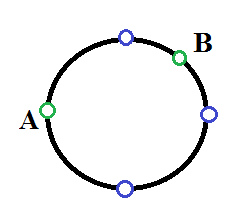Codeforces Round #394 (Div. 2) A,B,C,D,E
2 seconds
256 megabytes
standard input
standard output
On her way to programming school tiger Dasha faced her first test — a huge staircase!

The steps were numbered from one to infinity. As we know, tigers are very fond of all striped things, it is possible that it has something to do with their color. So on some interval of her way she calculated two values — the number of steps with even and odd numbers.
You need to check whether there is an interval of steps from the l-th to the r-th (1 ≤ l ≤ r), for which values that Dasha has found are correct.
In the only line you are given two integers a, b (0 ≤ a, b ≤ 100) — the number of even and odd steps, accordingly.
In the only line print "YES", if the interval of steps described above exists, and "NO" otherwise.
2 3
YES
3 1
NO
In the first example one of suitable intervals is from 1 to 5. The interval contains two even steps — 2 and 4, and three odd: 1, 3 and 5.
#include<bits/stdc++.h>
using namespace std;
#define ll long long
#define pi (4*atan(1.0))
#define eps 1e-14
#define bug(x) cout<<"bug"<<" "<<x<<endl;
const int N=1e5+,M=1e6+,inf=1e9+,mod=1e9+;
const ll INF=1e18+;
int main()
{
int a,b;
scanf("%d%d",&a,&b);
if(a==&&b==)
return puts("NO");
if(abs(a-b)<=)
printf("YES\n");
else
printf("NO\n");
return ;
}
2 seconds
256 megabytes
standard input
standard output
Running with barriers on the circle track is very popular in the country where Dasha lives, so no wonder that on her way to classes she saw the following situation:
The track is the circle with length L, in distinct points of which there are n barriers. Athlete always run the track in counterclockwise direction if you look on him from above. All barriers are located at integer distance from each other along the track.
Her friends the parrot Kefa and the leopard Sasha participated in competitions and each of them ran one lap. Each of the friends started from some integral point on the track. Both friends wrote the distance from their start along the track to each of the n barriers. Thus, each of them wrote n integers in the ascending order, each of them was between 0 and L - 1, inclusively.
 Consider an example. Let L = 8, blue points are barriers, and green points are Kefa's start (A) and Sasha's start (B). Then Kefa writes down the sequence[2, 4, 6], and Sasha writes down [1, 5, 7].
Consider an example. Let L = 8, blue points are barriers, and green points are Kefa's start (A) and Sasha's start (B). Then Kefa writes down the sequence[2, 4, 6], and Sasha writes down [1, 5, 7].
There are several tracks in the country, all of them have same length and same number of barriers, but the positions of the barriers can differ among different tracks. Now Dasha is interested if it is possible that Kefa and Sasha ran the same track or they participated on different tracks.
Write the program which will check that Kefa's and Sasha's tracks coincide (it means that one can be obtained from the other by changing the start position). Note that they always run the track in one direction — counterclockwise, if you look on a track from above.
The first line contains two integers n and L (1 ≤ n ≤ 50, n ≤ L ≤ 100) — the number of barriers on a track and its length.
The second line contains n distinct integers in the ascending order — the distance from Kefa's start to each barrier in the order of its appearance. All integers are in the range from 0 to L - 1 inclusively.
The second line contains n distinct integers in the ascending order — the distance from Sasha's start to each barrier in the order of its overcoming. All integers are in the range from 0 to L - 1 inclusively.
Print "YES" (without quotes), if Kefa and Sasha ran the coinciding tracks (it means that the position of all barriers coincides, if they start running from the same points on the track). Otherwise print "NO" (without quotes).
3 8
2 4 6
1 5 7
YES
4 9
2 3 5 8
0 1 3 6
YES
2 4
1 3
1 2
NO
The first test is analyzed in the statement.
暴力;
#include<bits/stdc++.h>
using namespace std;
#define ll long long
#define pi (4*atan(1.0))
#define eps 1e-14
#define bug(x) cout<<"bug"<<" "<<x<<endl;
const int N=1e5+,M=1e6+,inf=1e9+,mod=1e9+;
const ll INF=1e18+;
int a[N],b[N];
int p[N],q[N];
int check(int n,int st)
{
int en=;
for(int i=st;i<=n;i++)
if(q[i]!=p[en++])
return ;
for(int i=;i<st;i++)
if(q[i]!=p[en++])
return ;
return ;
}
int main()
{
int n,l;
scanf("%d%d",&n,&l);
for(int i=;i<=n;i++)
scanf("%d",&a[i]);
for(int i=;i<=n;i++)
scanf("%d",&b[i]);
for(int i=;i<n;i++)
p[i]=a[i+]-a[i];
p[n]=l-a[n]+a[];
for(int i=;i<=n;i++)
q[i]=b[i+]-b[i];
q[n]=l-b[n]+b[];
for(int i=;i<=n;i++)
{
if(check(n,i))
{
return puts("YES\n");
}
}
puts("NO\n");
return ;
}
2 seconds
256 megabytes
standard input
standard output
After overcoming the stairs Dasha came to classes. She needed to write a password to begin her classes. The password is a string of length n which satisfies the following requirements:
- There is at least one digit in the string,
- There is at least one lowercase (small) letter of the Latin alphabet in the string,
- There is at least one of three listed symbols in the string: '#', '*', '&'.

Considering that these are programming classes it is not easy to write the password.
For each character of the password we have a fixed string of length m, on each of these n strings there is a pointer on some character. The i-th character displayed on the screen is the pointed character in the i-th string. Initially, all pointers are on characters with indexes1 in the corresponding strings (all positions are numbered starting from one).
During one operation Dasha can move a pointer in one string one character to the left or to the right. Strings are cyclic, it means that when we move the pointer which is on the character with index 1 to the left, it moves to the character with the index m, and when we move it to the right from the position m it moves to the position 1.
You need to determine the minimum number of operations necessary to make the string displayed on the screen a valid password.
The first line contains two integers n, m (3 ≤ n ≤ 50, 1 ≤ m ≤ 50) — the length of the password and the length of strings which are assigned to password symbols.
Each of the next n lines contains the string which is assigned to the i-th symbol of the password string. Its length is m, it consists of digits, lowercase English letters, and characters '#', '*' or '&'.
You have such input data that you can always get a valid password.
Print one integer — the minimum number of operations which is necessary to make the string, which is displayed on the screen, a valid password.
3 4
1**2
a3*0
c4**
1
5 5
#*&#*
*a1c&
&q2w*
#a3c#
*&#*&
3
In the first test it is necessary to move the pointer of the third string to one left to get the optimal answer.

In the second test one of possible algorithms will be:
- to move the pointer of the second symbol once to the right.
- to move the pointer of the third symbol twice to the right.

思路:打表找到每行可以到三种不同字符的最小距离;暴力枚举三种出现的情况
#include<bits/stdc++.h>
using namespace std;
#define ll long long
#define pi (4*atan(1.0))
#define eps 1e-14
#define bug(x) cout<<"bug"<<" "<<x<<endl;
const int N=1e5+,M=1e6+,inf=1e8+,mod=1e9+;
const ll INF=1e18+;
char mp[][];
int n,m;
int dis[][];
void init()
{
for(int i=;i<;i++)
{
for(int j=;j<;j++)
dis[i][j]=inf;
}
}
int ans[];
int check(int x,int y,int z)
{
if(x==y||x==z||y==z)
return -;
ans[]=dis[x][]+dis[y][]+dis[z][];
ans[]=dis[x][]+dis[y][]+dis[z][];
ans[]=dis[x][]+dis[y][]+dis[z][];
ans[]=dis[x][]+dis[y][]+dis[z][];
ans[]=dis[x][]+dis[y][]+dis[z][];
ans[]=dis[x][]+dis[y][]+dis[z][];
int minn=ans[];
for(int i=;i<=;i++)
minn=min(minn,ans[i]);
return minn;
}
int main()
{
init();
scanf("%d%d",&n,&m);
for(int i=;i<=n;i++)
scanf("%s",mp[i]+);
for(int i=;i<=n;i++)
{
for(int j=;j<=m;j++)
{
int dis1=j-;
int dis2=m+-j;
if(mp[i][j]>=''&&mp[i][j]<='')
dis[i][]=min(dis1,min(dis2,dis[i][]));
else if(mp[i][j]=='*'||mp[i][j]=='&'||mp[i][j]=='#')
dis[i][]=min(dis1,min(dis2,dis[i][]));
else
dis[i][]=min(dis1,min(dis2,dis[i][]));
}
}
int ans=inf;
for(int i=;i<=n;i++)
{
for(int j=;j<=n;j++)
{
for(int k=;k<=n;k++)
{
int v=check(i,j,k);
if(v!=-)
{
ans=min(ans,v);
}
}
}
}
printf("%d\n",ans);
return ;
}
2 seconds
256 megabytes
standard input
standard output
Dasha logged into the system and began to solve problems. One of them is as follows:
Given two sequences a and b of length n each you need to write a sequence c of length n, the i-th element of which is calculated as follows: ci = bi - ai.
About sequences a and b we know that their elements are in the range from l to r. More formally, elements satisfy the following conditions: l ≤ ai ≤ r and l ≤ bi ≤ r. About sequence c we know that all its elements are distinct.

Dasha wrote a solution to that problem quickly, but checking her work on the standard test was not so easy. Due to an error in the test system only the sequence a and the compressed sequence of the sequence c were known from that test.
Let's give the definition to a compressed sequence. A compressed sequence of sequence c of length n is a sequence p of length n, so that pi equals to the number of integers which are less than or equal to ci in the sequence c. For example, for the sequencec = [250, 200, 300, 100, 50] the compressed sequence will be p = [4, 3, 5, 2, 1]. Pay attention that in c all integers are distinct. Consequently, the compressed sequence contains all integers from 1 to n inclusively.
Help Dasha to find any sequence b for which the calculated compressed sequence of sequence c is correct.
The first line contains three integers n, l, r (1 ≤ n ≤ 105, 1 ≤ l ≤ r ≤ 109) — the length of the sequence and boundaries of the segment where the elements of sequences a and b are.
The next line contains n integers a1, a2, ..., an (l ≤ ai ≤ r) — the elements of the sequence a.
The next line contains n distinct integers p1, p2, ..., pn (1 ≤ pi ≤ n) — the compressed sequence of the sequence c.
If there is no the suitable sequence b, then in the only line print "-1".
Otherwise, in the only line print n integers — the elements of any suitable sequence b.
5 1 5
1 1 1 1 1
3 1 5 4 2
3 1 5 4 2
4 2 9
3 4 8 9
3 2 1 4
2 2 2 9
6 1 5
1 1 1 1 1 1
2 3 5 4 1 6
-1
Sequence b which was found in the second sample is suitable, because calculated sequencec = [2 - 3, 2 - 4, 2 - 8, 9 - 9] = [ - 1, - 2, - 6, 0] (note that ci = bi - ai) has compressed sequence equals to p = [3, 2, 1, 4].
思路:模拟,排个序;
#pragma comment(linker, "/STACK:1024000000,1024000000")
#include<iostream>
#include<cstdio>
#include<cmath>
#include<string>
#include<queue>
#include<algorithm>
#include<stack>
#include<cstring>
#include<vector>
#include<list>
#include<set>
#include<map>
using namespace std;
#define ll long long
#define pi (4*atan(1.0))
#define eps 1e-14
#define bug(x) cout<<"bug"<<x<<endl;
const int N=2e5+,M=1e6+;
const ll INF=1e18+,mod=;
int n,l,r;
struct is
{
int a,p,pos;
bool operator <(const is &b)const
{
return p<b.p;
}
}a[N];
int ans[N];
int main()
{
scanf("%d%d%d",&n,&l,&r);
for(int i=;i<=n;i++)
scanf("%d",&a[i].a),a[i].pos=i;
for(int i=;i<=n;i++)
scanf("%d",&a[i].p);
sort(a+,a++n);
int st=l-a[].a+ ;
ans[a[].pos]=l;
for(int i=;i<=n;i++)
{
st=max(st,l-a[i].a);
if(st+a[i].a>r)return puts("-1");
ans[a[i].pos]=st+a[i].a;
st++;
}
for(int i=;i<=n;i++)
printf("%d ",ans[i]);
return ;
}
2 seconds
256 megabytes
standard input
standard output
Dasha decided to have a rest after solving the problem. She had been ready to start her favourite activity — origami, but remembered the puzzle that she could not solve.

The tree is a non-oriented connected graph without cycles. In particular, there always are n - 1 edges in a tree with n vertices.
The puzzle is to position the vertices at the points of the Cartesian plane with integral coordinates, so that the segments between the vertices connected by edges are parallel to the coordinate axes. Also, the intersection of segments is allowed only at their ends. Distinct vertices should be placed at different points.
Help Dasha to find any suitable way to position the tree vertices on the plane.
It is guaranteed that if it is possible to position the tree vertices on the plane without violating the condition which is given above, then you can do it by using points with integral coordinates which don't exceed 1018 in absolute value.
The first line contains single integer n (1 ≤ n ≤ 30) — the number of vertices in the tree.
Each of next n - 1 lines contains two integers ui, vi (1 ≤ ui, vi ≤ n) that mean that the i-th edge of the tree connects vertices ui and vi.
It is guaranteed that the described graph is a tree.
If the puzzle doesn't have a solution then in the only line print "NO".
Otherwise, the first line should contain "YES". The next n lines should contain the pair of integers xi, yi (|xi|, |yi| ≤ 1018) — the coordinates of the point which corresponds to the i-th vertex of the tree.
If there are several solutions, print any of them.
7
1 2
1 3
2 4
2 5
3 6
3 7
YES
0 0
1 0
0 1
2 0
1 -1
-1 1
0 2
6
1 2
2 3
2 4
2 5
2 6
NO
4
1 2
2 3
3 4
YES
3 3
4 3
5 3
6 3
In the first sample one of the possible positions of tree is:
题意:给你一棵树,平铺在二维坐标中,边平行x,y轴;
思路:利用类似二进制的思路;
#pragma comment(linker, "/STACK:1024000000,1024000000")
#include<iostream>
#include<cstdio>
#include<cmath>
#include<string>
#include<queue>
#include<algorithm>
#include<stack>
#include<cstring>
#include<vector>
#include<list>
#include<set>
#include<map>
using namespace std;
#define ll long long
#define pi (4*atan(1.0))
#define eps 1e-14
#define bug(x) cout<<"bug"<<x<<endl;
const int N=2e5+,M=1e6+;
const ll INF=1e18+,mod=;
int n;
struct is
{
int v,next;
}edge[N<<];
int edg,head[N];
int du[N];
pair<ll,ll>ans[N];
int c(int x)
{
if(x&)return x+;
return x-;
}
void init()
{
memset(head,-,sizeof(head));
edg=;
}
int flag[N][];
void add(int u,int v)
{
edg++;
edge[edg].v=v;
edge[edg].next=head[u];
head[u]=edg;
}
void dfs(int u,int fa,ll len)
{
for(int i=head[u];i!=-;i=edge[i].next)
{
int v=edge[i].v;
if(v==fa)continue;
//cout<<u<<" "<<v<<endl;
for(int i=;i<=;i++)
{
if(flag[u][i])continue;
flag[v][c(i)]=;
flag[u][i]=;
//cout<<u<<" "<<v<<" "<<i<<" "<<len<<endl;
if(i==)
ans[v]=make_pair(ans[u].first,ans[u].second+len);
else if(i==)
ans[v]=make_pair(ans[u].first,ans[u].second-len);
else if(i==)
ans[v]=make_pair(ans[u].first-len,ans[u].second);
else if(i==)
ans[v]=make_pair(ans[u].first+len,ans[u].second);
break;
}
dfs(v,u,len>>);
}
}
int check()
{
for(int i=;i<=n;i++)
if(du[i]>)
return ;
return ;
}
int main()
{
init();
scanf("%d",&n);
for(int i=;i<n;i++)
{
int u,v;
scanf("%d%d",&u,&v);
add(u,v),add(v,u);
du[u]++,du[v]++;
}
if(check()==)return puts("NO\n");
ans[]=make_pair(0LL,0LL);
dfs(,-,(1LL<<));
printf("YES\n");
for(int i=;i<=n;i++)
printf("%lld %lld\n",ans[i].first,ans[i].second);
return ;
}
2 seconds
256 megabytes
standard input
standard output
On her way to programming school tiger Dasha faced her first test — a huge staircase!

The steps were numbered from one to infinity. As we know, tigers are very fond of all striped things, it is possible that it has something to do with their color. So on some interval of her way she calculated two values — the number of steps with even and odd numbers.
You need to check whether there is an interval of steps from the l-th to the r-th (1 ≤ l ≤ r), for which values that Dasha has found are correct.
In the only line you are given two integers a, b (0 ≤ a, b ≤ 100) — the number of even and odd steps, accordingly.
In the only line print "YES", if the interval of steps described above exists, and "NO" otherwise.
2 3
YES
3 1
NO
In the first example one of suitable intervals is from 1 to 5. The interval contains two even steps — 2 and 4, and three odd: 1, 3 and 5.
Codeforces Round #394 (Div. 2) A,B,C,D,E的更多相关文章
- Codeforces Round #394 (Div. 2) E. Dasha and Puzzle(分形)
E. Dasha and Puzzle time limit per test 2 seconds memory limit per test 256 megabytes input standard ...
- Codeforces Round #394 (Div. 2) 颓废记
昨天晚上(今天凌晨),又忍不住去打CF.(本蒟弱到只能打Div.2)... 我觉得我可以用一个词概括我这次的CF: 呵呵 刚一开赛,我就codeforces访问失败.. 后来好不容易能上了,两三分钟才 ...
- Codeforces Round #394 (Div. 2) E. Dasha and Puzzle 构造
E. Dasha and Puzzle 题目连接: http://codeforces.com/contest/761/problem/E Description Dasha decided to h ...
- Codeforces Round #394 (Div. 2) D. Dasha and Very Difficult Problem 贪心
D. Dasha and Very Difficult Problem 题目连接: http://codeforces.com/contest/761/problem/D Description Da ...
- Codeforces Round #394 (Div. 2) C. Dasha and Password 暴力
C. Dasha and Password 题目连接: http://codeforces.com/contest/761/problem/C Description After overcoming ...
- Codeforces Round #394 (Div. 2) B. Dasha and friends 暴力
B. Dasha and friends 题目连接: http://codeforces.com/contest/761/problem/B Description Running with barr ...
- Codeforces Round #394 (Div. 2) A. Dasha and Stairs 水题
A. Dasha and Stairs 题目连接: http://codeforces.com/contest/761/problem/A Description On her way to prog ...
- Codeforces Round #394 (Div. 2) E. Dasha and Puzzle(dfs)
http://codeforces.com/contest/761/problem/E 题意:给出一棵树,现在要把这棵树上的结点放置在笛卡尔坐标上,使得每一条边与x轴平行或者与y轴平行.输出可行解,即 ...
- Codeforces Round #394 (Div. 2) C.Dasha and Password(暴力)
http://codeforces.com/contest/761/problem/C 题意:给出n个串,每个串的初始光标都位于0(列)处,怎样移动光标能够在凑出密码(每个串的光标位置表示一个密码的字 ...
- Codeforces Round #394 (Div. 2) B. Dasha and friends(暴力)
http://codeforces.com/contest/761/problem/B 题意: 有一个长度为l的环形跑道,跑道上有n个障碍,现在有2个人,给出他们每过多少米碰到障碍,判断他们跑的是不是 ...
随机推荐
- 【BZOJ2157】旅游 树链剖分+线段树
[BZOJ2157]旅游 Description Ray 乐忠于旅游,这次他来到了T 城.T 城是一个水上城市,一共有 N 个景点,有些景点之间会用一座桥连接.为了方便游客到达每个景点但又为了节约成本 ...
- Windows Phone 有关独立存储(一)
private const string foldername = "temp1"; private const string filename = foldername + &q ...
- IntelliJ Idea 2018 注册码
转自:http://idea.lanyus.com/ *.lanyus.com及*.qinxi1992.cn下的全部授权服务器已遭JetBrains封杀 请搭建自己的IntelliJ IDEA授权服务 ...
- mysql load data导入脚本
# !/bin/bash ############中文说明###################### #本程序的一些提示需要中文支持,如系统没有安装中文包,请先安装:yum -y groupinst ...
- Linux--vim编辑器和文件恢复
第五章 Vim编辑器和恢复ext4下误删除的文件-Xmanager工具 本节所讲内容: 5.1 vim的使用 5.2 实战:恢复ext4文件系统下误删除的文件 5.3 实战:使用xmanage ...
- .m2\repository\org\springframework\spring-beans\4.1.4.RELEASE\spring-beans-4.1.4.RELEASE.jar!\org\springframework\beans\factory\xml\spring-beans-4.1.xsd
<?xml version="1.0" encoding="UTF-8" standalone="no"?> <xsd:s ...
- 关于Python装饰器内层函数为什么要return目标函数的一些个人见解
https://blog.csdn.net/try_test_python/article/details/80802199 前几天在学装饰器的时候,关于装饰器内层函数调用目标函数时是否return目 ...
- mysql 数据操作 单表查询 group by 练习
小练习: 1. 查询岗位名以及岗位包含的所有员工名字 mysql> select post,group_concat(name) from employee group by post ; +- ...
- shell 环境变量的知识小结
环境变量的知识小结:·变量名通常要大写.·变量可以在自身的Shell及子Shell中使用.·常用export来定义环境变量.·执行env默认可以显示所有的环境变量名称及对应的值.·输出时用“$变量名” ...
- spring boot开启事务管理,使用事务的回滚机制,使两条插入语句一致
spring boot 事务管理,使用事务的回滚机制 1:配置事务管理 在springboot 启动类中添加 @EnableTransactionManagement //开启事务管理 @Enable ...
